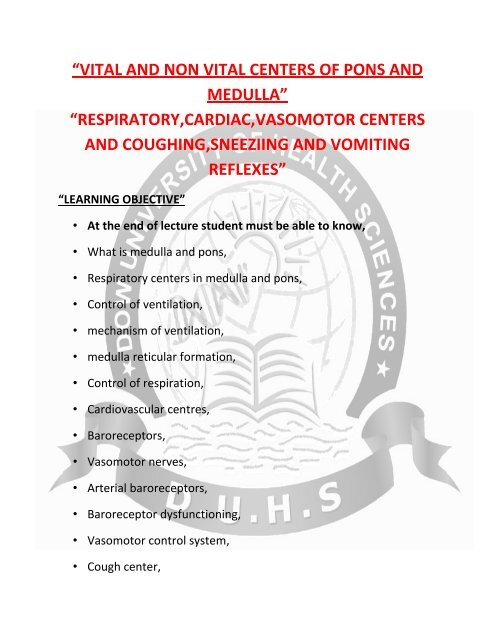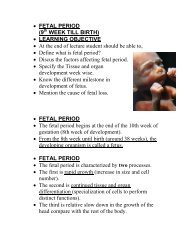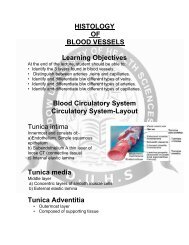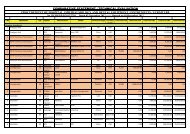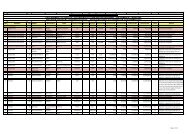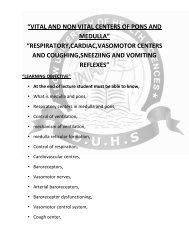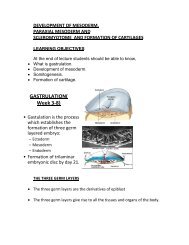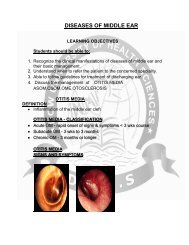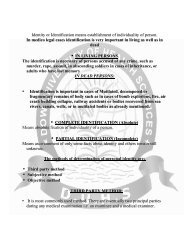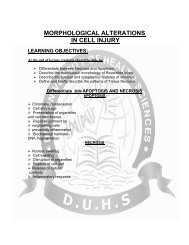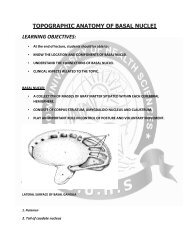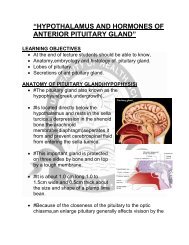“VITAL AND NON VITAL CENTERS OF PONS AND MEDULLA”
“VITAL AND NON VITAL CENTERS OF PONS AND MEDULLA”
“VITAL AND NON VITAL CENTERS OF PONS AND MEDULLA”
You also want an ePaper? Increase the reach of your titles
YUMPU automatically turns print PDFs into web optimized ePapers that Google loves.
<strong>“<strong>VITAL</strong></strong> <strong>AND</strong> <strong>NON</strong> <strong>VITAL</strong> <strong>CENTERS</strong> <strong>OF</strong> <strong>PONS</strong> <strong>AND</strong><br />
<strong>MEDULLA”</strong><br />
“RESPIRATORY,CARDIAC,VASOMOTOR <strong>CENTERS</strong><br />
<strong>AND</strong> COUGHING,SNEEZIING <strong>AND</strong> VOMITING<br />
REFLEXES”<br />
“LEARNING OBJECTIVE”<br />
• At the end of lecture student must be able to know,<br />
• What is medulla and pons,<br />
• Respiratory centers in medulla and pons,<br />
• Control of ventilation,<br />
• mechanism of ventilation,<br />
• medulla reticular formation,<br />
• Control of respiration,<br />
• Cardiovascular centres,<br />
• Baroreceptors,<br />
• Vasomotor nerves,<br />
• Arterial baroreceptors,<br />
• Baroreceptor dysfunctioning,<br />
• Vasomotor control system,<br />
• Cough center,
• Sneeze cneter,<br />
• Vomiting.<br />
“MEDULLA <strong>AND</strong> <strong>PONS</strong>”<br />
• Heart rate and blood pressure is controlled mainly from the<br />
cardiac center and the vasomotor center in the medulla<br />
respectively.<br />
• Ventilation is controlled from centers in the medulla and pons.<br />
• Both medulla and pons are part of the brain stem.<br />
• In addition, there are also other peripheral baroreceptors (BP<br />
control), and chemoreceptors (ventilation rate control) involved.<br />
“MEDULLA OBLONGATA”<br />
• medulla oblongata is the lower half of the brainstem.<br />
• The medulla contains the cardiac, respiratory, vomiting and<br />
vasomotor centers and deals with autonomic functions.<br />
• The medulla oblongata controls autonomic functions, and relays<br />
nerve signals between the brain and spinal cord.<br />
• It is also responsible for controlling several major points and<br />
autonomic functions of the body:<br />
• respiration ----- chemoreceptors<br />
• cardiac center ----- sympathetic, parasympathetic system<br />
• vasomotor center---- baroreceptors<br />
• reflex centers of vomiting, coughing, sneezing, and swallowing.
“CONTROL <strong>OF</strong> VENTILATION (CONTROL <strong>OF</strong> RESPIRATION)”<br />
• refers to the physiological mechanisms involved in the control of<br />
physiologic ventilation.<br />
• Gas exchange primarily controls the rate of respiration.<br />
• The most important function of breathing is gas exchange (of<br />
oxygen and carbon dioxide).<br />
• Thus the control of respiration is centered primarily on how well<br />
this is achieved by the lungs.<br />
“THE MECHANISM <strong>OF</strong> GENERATION <strong>OF</strong> THE VENTILATOR”<br />
• The mechanism of generation of the ventilatory pattern is not<br />
completely understood, but involves the integration of neural<br />
signals by respiratory control centers in the medulla and pons.<br />
• The nuclei known to be involved are divided into regions known<br />
as the following:<br />
“MEDULLA (RETICULAR FORMATION)”<br />
– ventral respiratory group (nucleus retroambigualis, nucleus<br />
ambiguus, nucleus parambigualis and the pre-Botzinger<br />
complex).<br />
– The ventral respiratory group controls voluntary forced<br />
exhalation and acts to increase the force of inspiration.<br />
– dorsal respiratory group (nucleus tractus solitarius).<br />
– The dorsal respiratory group controls mostly inspiratory<br />
movements and their timing.
“<strong>PONS</strong>”<br />
– pneumotaxic center.<br />
• Coordinates transition between inhalation and<br />
exhalation<br />
• Sends inhibitory impulses to the inspiratory area<br />
• The pneumotaxic center is involved in fine tuning of<br />
respiration rate.<br />
– apneustic center.<br />
• Coordinates transition between inhalation and<br />
exhalation<br />
• Sends stimulatory impulses to the inspiratory area –<br />
activates and prolongs inhalation (long deep breaths)<br />
• overridden by pneumotaxic control from the apneustic<br />
area to end inspiration<br />
There is further integration in the anterior horn cells of the spinal cord.<br />
• There is further integration in the anterior horn cells of the spinal<br />
cord<br />
• The spinal cord reflex responses include the activation of<br />
additional respiratory muscles as compensation,<br />
gasping response,<br />
hypoventilation, and<br />
an increase in breathing frequency and volume
“DETERMINANTS <strong>OF</strong> VENTILATORY RATE”<br />
• Ventilatory rate (minute volume) is tightly controlled and<br />
determined primarily by blood levels of carbon dioxide as<br />
determined by metabolic rate.<br />
• Blood levels of oxygen become important in hypoxia.<br />
• These levels are sensed by chemoreceptors in the medulla<br />
oblongata for pH, and the carotid and aortic bodies for oxygen<br />
and carbon dioxide.<br />
• Afferent neurons from the carotid bodies and aortic bodies are<br />
via the glossopharyngeal nerve (CN IX) and the vagus nerve (CN<br />
X), respectively.<br />
“FEEDBACK CONTROL”<br />
• Receptors play important roles in the regulation of respiration;<br />
central and peripheral chemoreceptors, and mechanoreceptors.<br />
• Central chemoreceptors of the central nervous system, located<br />
on the ventrolateral medullary surface, are sensitive to the pH of<br />
their environment.<br />
• Peripheral chemoreceptors act most importantly to detect<br />
variation of the oxygen in the arterial blood, in addition to<br />
detecting arterial carbon dioxide and pH.<br />
• Mechanoreceptors are located in the airways and parenchyma,<br />
and are responsible for a variety of reflex responses. These<br />
include:
– The Hering-Breuer reflex that terminates inspiration to<br />
prevent over inflation of the lungs, and the reflex responses<br />
of coughing, airway constriction, and hyperventilation.<br />
– The upper airway receptors are responsible for reflex<br />
responses such as, sneezing, coughing, closure of glottis, and<br />
hiccups.<br />
– The spinal cord reflex responses include the activation of<br />
additional respiratory muscles as compensation, gasping<br />
response, hypoventilation, and an increase in breathing<br />
frequency and volume.<br />
“CONTROL <strong>OF</strong> RESPIRATION”<br />
In addition to involuntary control of respiration by the respiratory<br />
center, respiration can be affected by conditions such as,<br />
• emotional state,<br />
• via input from the limbic system,<br />
• or temperature,<br />
• via the hypothalamus.<br />
Voluntary control of respiration is provided via,<br />
• the cerebral cortex,<br />
• although chemoreceptor reflex is capable of overriding conscious<br />
control<br />
“CARDIOVASCULAR CENTRE”
• The cardiovascular centre is a part of the human brain<br />
responsible for the regulation of the rate at which the heart beats<br />
• It is found in the medulla<br />
• Normally, the heart beats without nervous control, but in some<br />
situations (e.g., exercise, body trauma), the cardiovascular centre<br />
is responsible for altering the rate at which the heart beats<br />
• The cardiovascular centre effects changes to the heart rate via<br />
sympathetic fibres (to speed up the heart rate).<br />
• and the vagus nerve (to slow down the heart rate).<br />
• The accelerator and vagus nerves both connect to the sinoatrial<br />
node (SA node).<br />
• The cardiovascular centre also increases the stroke volume of the<br />
heart (that is, the amount of blood it pumps).<br />
• These two changes help to regulate the cardiac output, so that a<br />
sufficient amount of blood reaches tissue.<br />
• “BARORECEPTORS”<br />
• Baroreceptors (or baroceptors) are sensors located in the blood<br />
vessels of several mammals.<br />
• They are a type of mechanoreceptor that detects the pressure of<br />
blood flowing through them.<br />
• send messages to the central nervous system to increase or<br />
decrease total peripheral resistance and cardiac output.
• Baroreceptors act immediately as part of a negative feedback<br />
system called the baroreflex.<br />
• as soon as there is a change from the usual blood pressure mean<br />
arterial blood pressure, returning the pressure to a normal level.<br />
• They are an example of a short-term blood pressure regulation<br />
mechanism.<br />
• Baroreceptors detect the amount of stretch of the blood vessel<br />
walls.<br />
• and send the signal to the nervous system in response to this<br />
stretch<br />
• “VASOMOTOR NERVES”<br />
• collection of nerve cells in the medulla oblongata that receives<br />
information from sensory receptors in the circulatory system and<br />
brings about reflex changes in the rate of the heartbeat and in the<br />
diameter of blood vessels, so that the blood pressure can be<br />
adjusted.<br />
• The vasomotor centre also receives impulses from elsewhere in<br />
the brain, so that emotion (such as fear) may also influence the<br />
heart rate and blood pressure.<br />
• The centre works through vasomotor nerves of the sympathetic<br />
and parasympathetic systems.<br />
• The nucleus tractus solitarius in the medulla oblongata recognizes<br />
changes in the firing rate of action potentials from the<br />
baroreceptors, and influences cardiac output and systemic
vascular resistance through changes in the autonomic nervous<br />
system.<br />
• Baroreceptors can be divided into two categories: high-pressure<br />
arterial baroreceptors and low-pressure baroreceptors (also<br />
known as cardiopulmonary or volume receptors<br />
• If blood pressure falls, such as in hypovolaemic shock,<br />
baroreceptor firing rate decreases.<br />
• Signals from the carotid baroreceptors are sent via the<br />
glossopharyngeal nerve (cranial nerve IX).<br />
• Signals from the aortic baroreceptors travel through the vagus<br />
nerve (cranial nerve X).<br />
• If the arterial pressure is severely lowered, the baroreflex is<br />
activated .<br />
• “ARTERIAL BARORECEPTORS”<br />
• Arterial baroreceptors are present in the aortic arch and the<br />
carotid sinuses of the left and right internal carotid arteries.<br />
• The baroreceptors found within the aortic arch enable the<br />
examination of the blood being delivered to all the blood vessels<br />
via the systemic circuit.<br />
• the baroreceptors within the carotid arteries monitor the blood<br />
pressure of the blood being delivered to the brain.<br />
• “BARORECEPTOR CLASSIFICATION”
• Baroreceptors can be divided into two categories:<br />
• high-pressure arterial baroreceptors,<br />
• and low-pressure baroreceptors (also known as cardiopulmonary<br />
or volume receptors<br />
• “VASOMOTOR CONTROL CENTRE”<br />
• The Vasomotor Control Centre (VCC) is located in the medulla<br />
oblongata in the brain.<br />
• and regulates the vascular shunt mechanism.<br />
• This basically redistributes blood during exercise and at rest<br />
accordingly.<br />
• “VASOMOTOR CONTROL”<br />
• during rest your muscle tissue require less oxygen and glucose.<br />
• so only 30 percent of blood is supplied to skeletal muscle.<br />
• The remaining 70 percent is supplied to the main body organs<br />
such as the liver, heart etc.<br />
• This is done by two main processes : VASODILATION and<br />
VASOCONSTRICITON.<br />
• These basically mean the widening and narrowing of blood<br />
vessels.<br />
• During exercise the body obviously has a greater demand for<br />
oxygen and glucose for aerobic respiration.
• or else it would have an onset for blood lactate accumulation,<br />
and would have to respire anaerobically.<br />
• With this in mind, the process above simply reverses to meet the<br />
demands of skeletal muscle.<br />
• 70 percent of blood goes to the muscles and the remaining 30<br />
percent is supplied to body organs.<br />
• Again vasodilation occurs, but this time in muscle arterioles and<br />
precapillary sphincters- to enable greater blood flow to the<br />
muscle.<br />
• therefore providing it with more oxygen and glucose for aerobic<br />
respiration.<br />
• In turn the organ arterioles and precapillary sphincters<br />
vasoconstrict, thus reducing the blood supply<br />
• “VASOMOTOR CONTROL CENTRE”<br />
• Located in Medulla Oblongata<br />
• During exercise messages from chemoreceptors stimulate<br />
sympathetic nerves located in the smooth muscle walls of the<br />
blood vessels.<br />
• Vasoconstriction of arterioles supplying non vital organs takes<br />
place.<br />
• Pre-capillary sphincters constrict to reduce blood flow to these<br />
organs.<br />
• Vasodilation of arterioles supplying more active working muscles<br />
to allow more blood flow
• Pre-capillary sphincters relax to increase blood flow to these<br />
organs.<br />
• “COUGH CENTER”<br />
• The cough center of the brain is a region of the brain which<br />
controls coughing, located in the medulla oblongata area of the<br />
brain.<br />
• Antitussives and other cough medicines focus their action on the<br />
cough center.<br />
• “SNEEZE CENTER”<br />
• The sneeze center is a part of the brain that not many people<br />
have heard of.<br />
• If the inside of your nose gets a tickle, then the sneeze center<br />
alerts all the other muscles that work together to sneeze.<br />
• Sneezing is a reflex.<br />
• A reflex is where your body does something automatically and is<br />
something that you have no control over.<br />
• “SNEEZING”<br />
• Sneezing is a primitive airway-protection reflex usually provoked<br />
by nasal mucosal irritation.<br />
• Several investigators have postulated that a "sneezing center"<br />
coordinating the sneeze reflex is located in the rostral lateral<br />
medulla.
• on the basis of case reports and animal experiments showing that<br />
exaggerated or absent sneezing results from lesions in this area.<br />
• “VOMITING”<br />
• Vomiting (known medically as emesis and informally as throwing<br />
up and a number of other terms) is the forceful expulsion of the<br />
contents of one's stomach through the mouth and sometimes the<br />
nose.<br />
• Vomiting may result from many causes, ranging from gastritis or<br />
poisoning to brain tumors.<br />
• or elevated intracranial pressure.<br />
• The feeling that one is about to vomit is called nausea, which<br />
usually precedes, but does not always lead to, vomiting.<br />
• Receptors on the floor of the fourth ventricle of the brain<br />
represent a chemoreceptor trigger zone, known as the area<br />
postrema, stimulation of which can lead to vomiting.<br />
• The area postrema is a circumventricular organ and as such lies<br />
outside the blood-brain barrier.<br />
• it can therefore be stimulated by blood-borne drugs that can<br />
stimulate vomiting or inhibit it.<br />
• The vestibular system which sends information to the brain via<br />
cranial nerve VIII (vestibulocochlear nerve).<br />
• It plays a major role in motion sickness and is rich in muscarinic<br />
receptors and histamine H1 receptors.
• Cranial nerve X (vagus nerve), which is activated when the<br />
pharynx is irritated, leading to a gag reflex.<br />
• Vagal and enteric nervous system inputs that transmit<br />
information regarding the state of the gastrointestinal system.<br />
• Irritation of the GI mucosa by chemotherapy, radiation,<br />
distention, or acute infectious gastroenteritis activates the 5-HT3<br />
receptors of these inputs.<br />
• The CNS mediates vomiting arising from psychiatric disorders and<br />
stress from higher brain centers.<br />
• REFERENCES.<br />
INTERNET.


